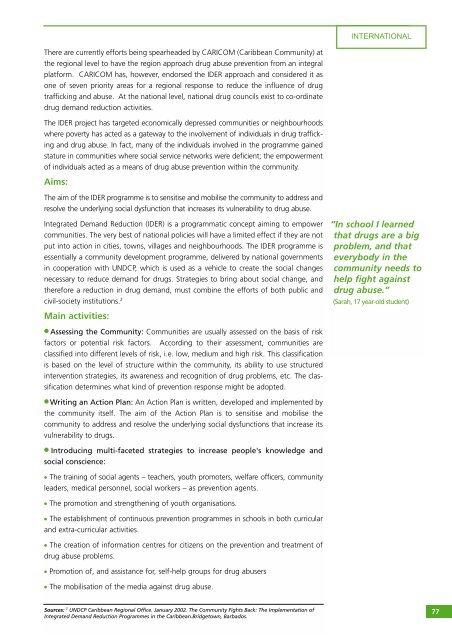PDF (Lessons learned in drug abuse prevention: a global review)
PDF (Lessons learned in drug abuse prevention: a global review)
PDF (Lessons learned in drug abuse prevention: a global review)
Create successful ePaper yourself
Turn your PDF publications into a flip-book with our unique Google optimized e-Paper software.
INTERNATIONAL<br />
There are currently efforts be<strong>in</strong>g spearheaded by CARICOM (Caribbean Community) at<br />
the regional level to have the region approach <strong>drug</strong> <strong>abuse</strong> <strong>prevention</strong> from an <strong>in</strong>tegral<br />
platform. CARICOM has, however, endorsed the IDER approach and considered it as<br />
one of seven priority areas for a regional response to reduce the <strong>in</strong>fluence of <strong>drug</strong><br />
traffick<strong>in</strong>g and <strong>abuse</strong>. At the national level, national <strong>drug</strong> councils exist to co-ord<strong>in</strong>ate<br />
<strong>drug</strong> demand reduction activities.<br />
The IDER project has targeted economically depressed communities or neighbourhoods<br />
where poverty has acted as a gateway to the <strong>in</strong>volvement of <strong>in</strong>dividuals <strong>in</strong> <strong>drug</strong> traffick<strong>in</strong>g<br />
and <strong>drug</strong> <strong>abuse</strong>. In fact, many of the <strong>in</strong>dividuals <strong>in</strong>volved <strong>in</strong> the programme ga<strong>in</strong>ed<br />
stature <strong>in</strong> communities where social service networks were deficient; the empowerment<br />
of <strong>in</strong>dividuals acted as a means of <strong>drug</strong> <strong>abuse</strong> <strong>prevention</strong> with<strong>in</strong> the community.<br />
Aims:<br />
The aim of the IDER programme is to sensitise and mobilise the community to address and<br />
resolve the underly<strong>in</strong>g social dysfunction that <strong>in</strong>creases its vulnerability to <strong>drug</strong> <strong>abuse</strong>.<br />
Integrated Demand Reduction (IDER) is a programmatic concept aim<strong>in</strong>g to empower<br />
communities. The very best of national policies will have a limited effect if they are not<br />
put <strong>in</strong>to action <strong>in</strong> cities, towns, villages and neighbourhoods. The IDER programme is<br />
essentially a community development programme, delivered by national governments<br />
<strong>in</strong> cooperation with UNDCP, which is used as a vehicle to create the social changes<br />
necessary to reduce demand for <strong>drug</strong>s. Strategies to br<strong>in</strong>g about social change, and<br />
therefore a reduction <strong>in</strong> <strong>drug</strong> demand, must comb<strong>in</strong>e the efforts of both public and<br />
civil-society <strong>in</strong>stitutions. 2<br />
“In school I <strong>learned</strong><br />
that <strong>drug</strong>s are a big<br />
problem, and that<br />
everybody <strong>in</strong> the<br />
community needs to<br />
help fight aga<strong>in</strong>st<br />
<strong>drug</strong> <strong>abuse</strong>.”<br />
(Sarah, 17 year-old student)<br />
Ma<strong>in</strong> activities:<br />
● Assess<strong>in</strong>g the Community: Communities are usually assessed on the basis of risk<br />
factors or potential risk factors. Accord<strong>in</strong>g to their assessment, communities are<br />
classified <strong>in</strong>to different levels of risk, i.e. low, medium and high risk. This classification<br />
is based on the level of structure with<strong>in</strong> the community, its ability to use structured<br />
<strong>in</strong>tervention strategies, its awareness and recognition of <strong>drug</strong> problems, etc. The classification<br />
determ<strong>in</strong>es what k<strong>in</strong>d of <strong>prevention</strong> response might be adopted.<br />
● Writ<strong>in</strong>g an Action Plan: An Action Plan is written, developed and implemented by<br />
the community itself. The aim of the Action Plan is to sensitise and mobilise the<br />
community to address and resolve the underly<strong>in</strong>g social dysfunctions that <strong>in</strong>crease its<br />
vulnerability to <strong>drug</strong>s.<br />
● Introduc<strong>in</strong>g multi-faceted strategies to <strong>in</strong>crease people's knowledge and<br />
social conscience:<br />
● The tra<strong>in</strong><strong>in</strong>g of social agents – teachers, youth promoters, welfare officers, community<br />
leaders, medical personnel, social workers – as <strong>prevention</strong> agents.<br />
● The promotion and strengthen<strong>in</strong>g of youth organisations.<br />
● The establishment of cont<strong>in</strong>uous <strong>prevention</strong> programmes <strong>in</strong> schools <strong>in</strong> both curricular<br />
and extra-curricular activities.<br />
● The creation of <strong>in</strong>formation centres for citizens on the <strong>prevention</strong> and treatment of<br />
<strong>drug</strong> <strong>abuse</strong> problems.<br />
● Promotion of, and assistance for, self-help groups for <strong>drug</strong> <strong>abuse</strong>rs<br />
● The mobilisation of the media aga<strong>in</strong>st <strong>drug</strong> <strong>abuse</strong>.<br />
Sources: 2 UNDCP Caribbean Regional Office. January 2002. The Community Fights Back: The Implementation of<br />
Integrated Demand Reduction Programmes <strong>in</strong> the Caribbean.Bridgetown, Barbados.<br />
77
















